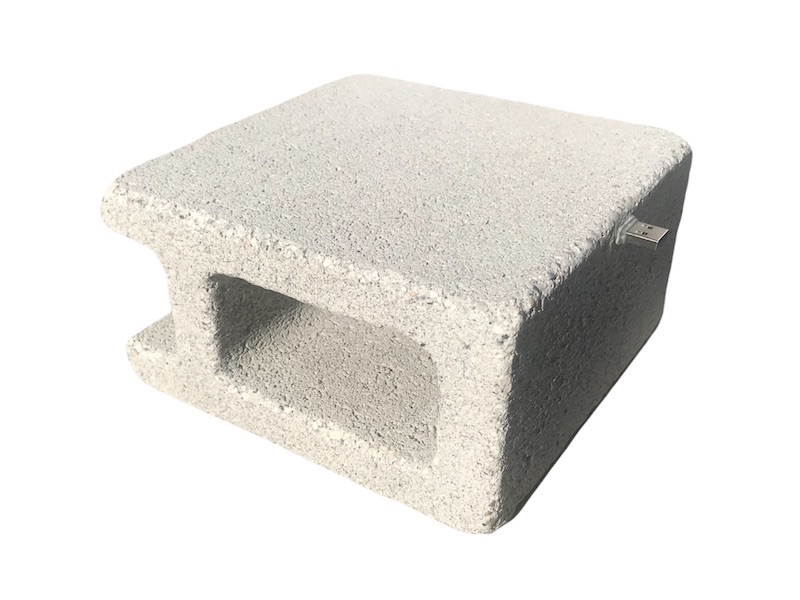|

2021-2021.mocaf.7708-7708.1-1
An object including a sound that was being played at the opening of MOCAF on 11 March 2021
Limited to 3
Size: 19x19x10cm
Material: concrete, USB, MP3
Price: 7 7 0 8
2021年3月11日MOCAFのオープニングで流れていたサウンドを含んだオブジェ
限定3
サイズ:19x19x10cm
素材:コンクリート、USB、MP3
価格:7 7 0 8
●
|
Uncanny Wall
“Musical innovation is full of danger to the State,
for when modes of music change,
the laws of the State always change with them.”
- Plato
At first glance, this piece appears to be nothing more than a concrete block, but once you notice certain points, it seems to be something inexplicable. Please take a closer look once again. What do you think? Concrete block is a material used to build walls. Therefore, it is clear that the theme of this work is "wall. It is connected to the question, "What is a wall? However, for some reason, a USB flash drive is plugged into the wall. This small oddity leads us to the not-so-familiar "inexplicable wall.
Humans have been building walls since around 8300 BC. Many walls, such as the Berlin Wall, the Great Wall of China, and the Wall of Lamentation, have been built to separate people from each other. Architectural historian Ian Wollner describes the wall at Jericho as "the oldest of its kind. The oldest of its kind, this wall may have appeared without a specific reason. Rather, it created its own underlying principle, the idea of difference itself, that there is not only an "us" but also a "them." [1] Art, for example, has since built many walls. For example, Bosco Sodi's "The Wall" (2017), which addresses the issue of the U.S.-Mexico border wall; Seal Floyer's "Untitled Installation (Dotted Line)" (1993-), which imagines the severing of a wall; and Chimera's "The Wall" (2017), which reconfigures walls around the world to reveal the existence of walls after globalization. Chim↑Pom's "It's the wall world" (2014-), which reconstructed walls around the world to reveal the existence of walls after globalization, are some of the most important wall artworks in art history. On the other hand, 2021-2021.mocaf.7708-7708.1-1 is located in the context of 311. The "wall" implied by this work has a different character from previous walls. The "they" behind the wall are not human beings. It has two characteristics. One is a "super levee" to protect people from the tsunami. The other is the wall inside the nuclear power plant to protect people from radiation (the so-called "five walls"). Thus, the wall suggests a relatively new kind of wall in human history, one that separates humans from nature, or humans from radiation, rather than the conventional wall that separates threats between different people, i.e., between humans and non-human threats.
This USB flash drive contains some data. It is the sound that was played at the opening of MOCAF on March 11, 2021. Usually, a work of art is linked to the name of the artist, but this work does not specify it. Names have social meanings that function among people, but the creator of this work does not seem to need them because he is oriented toward others other than humanity. One piece of information that can be disclosed with his consent is that the creator of this work was once involved in the production of software used at TEPCO's Fukushima Daiichi Nuclear Power Station (he subsequently left that position after 311). In light of the above, not a few people can sense the confusion that swirled in the 10 years since 311, and the release from that confusion in this sound. The sounds that remind us of "them," the others, are embedded within the block. A strange sound is preserved in a part of a strange wall. What are these puzzling walls?
The poet Allen Ginsberg said thus. "’ When the mode of the music changes, the walls of the city shake,’ said Plato out of Pythagoras. He disapproved of changing the mode of music because it meant destabilization of the older society. But when people began moving to a different rhythm, that affects the whole body and thinking process and a new consciousness rises." He did not approve of this, because changing the style of music meant destabilization of the old society. But when people begin to move to a different rhythm, it affects the whole body and the thought process, and a new consciousness rises."[2] A future in which "a new consciousness rises" through "2021-2021.mocaf.7708-7708.1-1" may not be so far off. What kind of consciousness will it be? At the very least, we can say that it is the consciousness of "them," which is not a human being. Of course, "2021-2021.mocaf.7708-7708.1-1" is not a wall itself, but part of that "impenetrable wall. What kind of wall will this block build, and what kind of relationship will we, the human race, have with "them"? Perhaps no one knows yet.
[1]Volner, Ian. The Great Great Wall: Along the Borders of History from China to Mexico (p. 18). Harry N. Abrams. Kindle Edition.
[2]https://www.thirteen.org/wnet/newyork/series/interview/ginsberg.html
不可解な壁
「音楽の技術革新は、国家にとって危険に満ちている。
音楽の様式が変わるにつれ、国家の基本的な法が常に変化するからだ。」
ー プラトン
一見すると、ただのコンクリートブロックでしかないこの作品は、ある点に気づくと、何か不可解なものに思えてきます。今一度、よくご覧ください。いかがでしょうか。コンクリートブロックは壁をつくるための素材です。よって、この作品が「壁」をテーマにしていることは明らかです。それは「壁とは何か」という 問いと結びついています。しかし、そこにはなぜか、USBフラッシュドライブが差し込まれています。このささやかな異様さは、決して馴染み深いとは言えない「不可解な壁」へと繋がっていきます。
人類は、紀元前8300年頃から壁をつくってきたとされています。ベルリンの壁、万里の長城、嘆きの壁など、多くの壁は、人と人を隔てるものとして建設されてきました。建築史家、イアン・ヴォルナーはイェリコの壁についてこう述べています。「その種の最古であるこの壁は、特定の理由なくして現れたのかもしれない。そうではなく、それ自身の根本原理、つまり、そこには「わたしたち」だけではなく「かれら」がいるという、差異そのもののアイデアを創出したのだと」[1]。たとえばアートは、その後、多くの壁をつくってきました。アメリカとメキシコの国境の壁を問題にしたボスコ・ソディの『壁』(2017)、壁の切断を 想像させるシール・フロイヤーの『Untitled Installation (Dotted Line)』(1993-)、世界各地の壁を再構成しグローバリゼーション以降の壁の存在を顕在化させたChim↑Pomの『It’s the wall world』(2014-)など、アート ヒストリーにおける重要なウォール・アートは少なくありません。一方、この『2021-2021.mocaf.7708-7708.1-1』は、311の文脈に位置しています。この作品が暗示する 「壁」は、これまでの壁とは異なる性質を持っています。つまり、その壁の向こうの「かれら」は、人間で はないのです。そこには2つの特徴があります。ひとつは、津波から人を守るための「スーパー堤防」。もうひとつは、放射能から人を守るための原子力発電所内の壁(いわゆる「5重の壁」)です。よってその壁 は、異なる人々の間に介在する脅威を隔てるこれまでの壁ではなく、人類と自然、あるいは人類と放射能を 隔てる、人類史上比較的新しい種類の壁、つまり、人類と人類以外の脅威を隔てる壁を示唆しています。
このUSBフラッシュドライブには、あるデータが保管されています。それは2021年3月11日MOCAFのオー プニングで流れていたサウンドです。通常作品は、アーティストの名前と連動していますが、この作品にはそれが明記されていません。名前は人々の間で機能する社会的意味を持ちますが、この作品の制作者は、人類以外の他者を志向しているため、それを必要としていないようです。本人の同意の上で公開できる情報をひとつ挙げると、この作品の制作者は、東京電力福島第一原子力発電所で使われるソフトウェア制作の仕事 に携わっていた経験があるということです(その後311をきっかけにその方はその職を離れました)。以上を鑑みた時、311から10年という月日の中で渦巻いた混乱と、そこからの開放をこのサウンドに感じ 取る人は、決して少なくないはでしょう。他者である「かれら」を想起させるサウンドが、ブロックの中に埋め込まれている。奇妙な壁の一部に、奇妙な音が保存されている。この不可解な壁は、一体何なのか。
詩人、アレン・ギンズバーグはこのように話しています。「『音楽の様式が変わると、都市の壁は揺らぐ』とピタゴラス派のプラトンは言った。音楽の様式が変わることは古い社会の不安定化を意味したために、彼はそれを良しとしなかった。しかし、人々が異なるリズムで動き始めれば、体全体や思考プロセスに影響を 及ぼし、新しい意識が立ちあがる」[2]。『2021-2021.mocaf.7708-7708.1-1』によって「新しい意識が立ち上がる」未来は、そう遠くないかもしれません。それはどんな意識なのでしょうか。少なくともそれは、 人間ではない、「かれら」の意識だと言えそうです。もちろん『2021-2021.mocaf.7708-7708.1-1』は壁そ のものではなく、その「不可解な壁」の一部です。このブロックがどんな壁を築き、わたしたち人類と「かれら」がどのような関係を築くのか。おそらくはまだ、誰にもわかりません。
[1]Volner, Ian. The Great Great Wall: Along the Borders of History from China to Mexico (p. 18). Harry N. Abrams. Kindle Edition.
[2]https://www.thirteen.org/wnet/newyork/series/interview/ginsberg.html
MOCAF
info@mocaf.art
1-83, Chuoh, Tomioka, Futaba, Fukushima, 979- 1112, Japan
〒979-1112 福島県双葉郡富岡町中央1−83
| |
